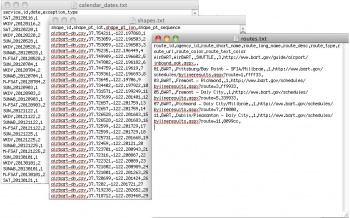General Transit Feed Specification
Introduction
The General Transit Feed Specification (GTFS) defines a common format for public transportation schedules and associated geographic information. The format was developed in 2005, when Trimet in Portland, Oregon began working with Google on incorporating transit agency data in their trip planners.[1] They came up with Google Transit Feed Specification, which was easily maintainable and could be imported into Google Maps. Google offered their trip planning services for free to any agency that formatted and maintained their transit data in that format, later to become called General Transit Feed Specification. Now, GTFS has become the most popularly-used data format in the world, with increasing numbers of agencies choosing to share their transit data with the public.
GTFS "feeds" allow public transit agencies to publish their transit data and developers to use that data to write applications. The feeds are represented in a series of text files that are compressed into a ZIP file, and include information such as fixed-route schedules, routes, and bus stop data. Many transit agencies have created and published GTFS data with the primary purpose being integration with Google Maps. However, GTFS data can used by a variety of third-party software applications for many purposes, such as trip planning, ridesharing, and mobile applications.
The Many Uses of GTFS Data--A Summary
"The Many Uses of GTFS Data", published by Antrim and Barbeau (2013), provides an overview of the GTFS opportunities for transit agencies and describes many different uses and benefits that can assist agencies in maximizing their investment in GTFS data.
Creating and Maintaining a GTFS Dataset
Transit agencies must choose between formatting a GTFS dataset in-house or outsourcing the task. The datasets have to be updated when there are schedule changes, and since major transit agencies update their schedules several times a year, some agencies might find greater benefits to outsourcing. If agencies choose to outsource, the cost per route ranges from $200 to $500, depending on the complexity of the route and availability of existing route data. [2]
Disseminating GTFS Data
Some agencies have chosen to share their transit data with select vendors such as Google Transit. They are typically concerned with legal exposure due to the lack of accuracy of data, loss of control of agency brand, and loss of control of dissemination of transit service information. However, many others feel the benefits of open transit data outweigh the risks, since developers can screen-scrape agency websites, which is not ideal for either party. Currently, over 200 transit agencies in the United States have chosen to openly share their GTFS data. [3]
The Google Transit Partner Program allows public transportation agencies to provide schedules and geographic information to Google Maps and other Google applications that show transit information. The website provides instructions for agencies just starting the GTFS sharing process and gives suggestions on how to create high-quality feeds. [4] For agencies that wish to make their data available to everyone, they can share the feeds on websites such as GTFS Data Exchange, which was designed to help developers and transit agencies efficiently share and retrieve GTFS data. [5]
Applications Based on GTFS
The following are just a few examples of the types of applications and names of existing application that use GTFS.
- Trip planning and maps
- Google Maps is currently implemented for most transit agencies that publish GTFS. Other examples of trip planning applications are Bing Maps and OpenTripPlanner.
- Timetable creation
- Timetable Publisher is free, open-source software that creates timetables in both HTML and PDF formats. TriMet in Portland, Oregon uses TimeTable Publisher to create all its timetables, as does Hampton Roads Transit in the south-eastern Virginia area.
- Data visualization
- Walk Score is website that helps people quantify “walkability” of an area by showing the nearby amenities within walking distance. The website also has a Transit Score, that rates how well an address is served by public transportation.
- Accessibility
- The Travel Assistant Device (TAD) is designed for sight-impaired or intellectually-disabled passengers. Phones with the application installed give audio and vibrating alerts when it is time for the passenger to pull the stop cord and alight from the bus
- Real-time transit information
- Newer formats, such as GTFS-realtime and SIRI, can be added as an extension to a basic GTFS format so transit agencies can share real-time information. NextBus is a vendor that provides real-time transit information in many cities, such as for the Los Angeles Metro.
References
Additional Reading
Shasta County Regional Transportation Planning Agency. "Northern California Google Transit Feasibility Study.". (2009).
- The Shasta RTPA led a study on the feasibility of integrating small-urban and rural public transit service schedules and geographic information with Google Transit. The study makes recommendations on how Google Transit can be improved to address the needs of small rural agencies.
Florida Department of Transportation. "SunRail Electronic Trip Planning Study Final Report" (2013).
- This report was prepared for the FDOT in advance of their SunRail launch; it analyzes various online trip planning options for SunRail to consider, and includes a section on GTFS's benefits, risks, and applications.
